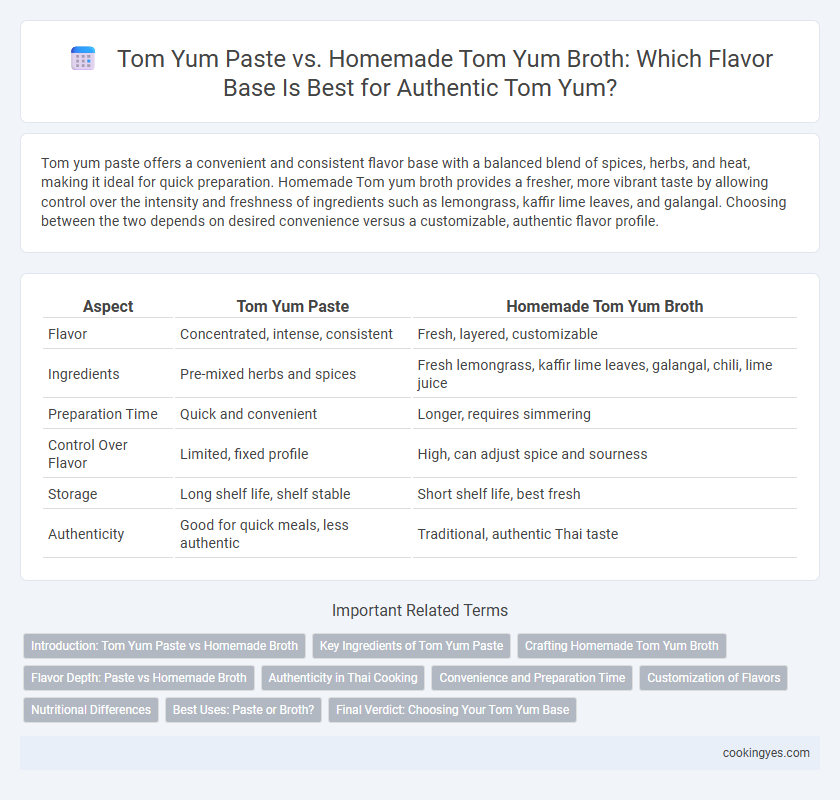Tom yum paste offers a convenient and consistent flavor base with a balanced blend of spices, herbs, and heat, making it ideal for quick preparation. Homemade Tom yum broth provides a fresher, more vibrant taste by allowing control over the intensity and freshness of ingredients such as lemongrass, kaffir lime leaves, and galangal. Choosing between the two depends on desired convenience versus a customizable, authentic flavor profile.
Table of Comparison
| Aspect | Tom Yum Paste | Homemade Tom Yum Broth |
|---|---|---|
| Flavor | Concentrated, intense, consistent | Fresh, layered, customizable |
| Ingredients | Pre-mixed herbs and spices | Fresh lemongrass, kaffir lime leaves, galangal, chili, lime juice |
| Preparation Time | Quick and convenient | Longer, requires simmering |
| Control Over Flavor | Limited, fixed profile | High, can adjust spice and sourness |
| Storage | Long shelf life, shelf stable | Short shelf life, best fresh |
| Authenticity | Good for quick meals, less authentic | Traditional, authentic Thai taste |
Introduction: Tom Yum Paste vs Homemade Broth
Tom yum paste offers a convenient and consistent flavor base, blending lemongrass, kaffir lime leaves, galangal, and chili in a balanced, ready-to-use form. Homemade tom yum broth allows for customization and freshness, using fresh herbs and ingredients simmered to extract deeper, more nuanced flavors that highlight regional variations. Comparing the two, tom yum paste provides speed and uniformity, while homemade broth delivers a richer, more authentic taste experience.
Key Ingredients of Tom Yum Paste
Tom yum paste contains concentrated essential ingredients such as lemongrass, galangal, kaffir lime leaves, chili, and shrimp paste that create an intense and balanced flavor base. Homemade Tom yum broth allows for customization of sourness, spice, and freshness by using fresh herbs and ingredients, resulting in a more vibrant and aromatic soup. The paste provides convenience and consistency, while homemade broth offers a nuanced depth and authentic taste aligned with traditional Thai cooking.
Crafting Homemade Tom Yum Broth
Crafting homemade Tom Yum broth involves simmering fresh ingredients like lemongrass, kaffir lime leaves, galangal, and bird's eye chilies to extract vibrant, aromatic flavors that surpass store-bought Tom Yum paste. This approach allows precise control over sourness from tamarind and heat intensity, creating a balanced and authentic taste profile. The fresh broth yields a more complex and richer umami presence compared to the often overly salty and preservative-laden commercial pastes.
Flavor Depth: Paste vs Homemade Broth
Tom yum paste offers a convenient and consistent flavor base with concentrated ingredients, delivering a balanced blend of sour, spicy, and savory notes. Homemade Tom yum broth, crafted from fresh herbs and aromatics like lemongrass, kaffir lime leaves, and galangal, provides a richer and more complex flavor depth with vibrant, layered nuances. The fresh ingredients in homemade broth create an authentic taste profile that often surpasses the uniform flavor of store-bought paste.
Authenticity in Thai Cooking
Tom yum paste provides a quick, convenient flavor base that captures essential Thai ingredients like lemongrass, kaffir lime, and galangal, but often lacks the depth and freshness found in homemade Tom yum broth. Authentic Thai cooking emphasizes balancing fresh herbs and spices, which homemade broth delivers by simmering whole ingredients to extract vibrant, nuanced flavors. Using homemade Tom yum broth ensures a richly layered, aromatic profile that reflects traditional culinary practices and elevates the dish's authentic taste.
Convenience and Preparation Time
Tom yum paste offers significant convenience with its ready-to-use blend of herbs and spices, reducing preparation time to just minutes, making it ideal for quick meals. Homemade Tom yum broth requires a longer cooking process, involving simmering fresh ingredients like lemongrass, kaffir lime leaves, galangal, and chili, which enhances depth of flavor but demands more effort. Choosing between the two depends on whether speed or flavor complexity takes priority in meal preparation.
Customization of Flavors
Tom yum paste offers a convenient and consistent flavor base, typically blending key ingredients like lemongrass, kaffir lime leaves, and galangal in balanced proportions. Homemade Tom yum broth allows for greater customization, enabling cooks to adjust sourness, spiciness, and herb freshness to individual taste preferences. This flexibility enhances the ability to highlight specific flavor notes, resulting in a more personalized and vibrant Tom yum experience.
Nutritional Differences
Tom yum paste typically contains added preservatives, sugar, and sodium, resulting in higher sodium levels and fewer fresh nutrients compared to homemade Tom yum broth, which uses natural ingredients like fresh lemongrass, galangal, and kaffir lime leaves that retain vitamins and antioxidants. Homemade broth offers greater control over ingredient quality and quantity, reducing unhealthy additives and enhancing nutritional content such as vitamins A and C, essential oils, and minerals. Nutritional differences significantly affect health benefits, with homemade broth promoting better digestion and immune support due to its fresh, nutrient-dense components.
Best Uses: Paste or Broth?
Tom yum paste offers a concentrated and consistent flavor ideal for quick meals and easy portion control, making it perfect for stir-fries or quick soups. Homemade tom yum broth delivers a fresher, more complex profile with customizable spice levels, enhancing dishes that benefit from a nuanced and vibrant base like traditional tom yum soup. Choosing between paste or broth depends on the desired depth of flavor and cooking convenience, with paste favored for speed and broth for authenticity in recipes.
Final Verdict: Choosing Your Tom Yum Base
Tom yum paste offers a convenient and consistent flavor base, combining key ingredients like lemongrass, kaffir lime leaves, galangal, and chili in a balanced blend suitable for quick preparation. Homemade Tom yum broth allows for customization of intensity and freshness by simmering fresh herbs and spices, enhancing depth and authenticity that paste sometimes lacks. Final verdict depends on preference: use paste for ease and reliability, or homemade broth for a vibrant, nuanced soup experience.
Tom yum paste vs homemade Tom yum broth for flavor base Infographic

 cookingyes.com
cookingyes.com